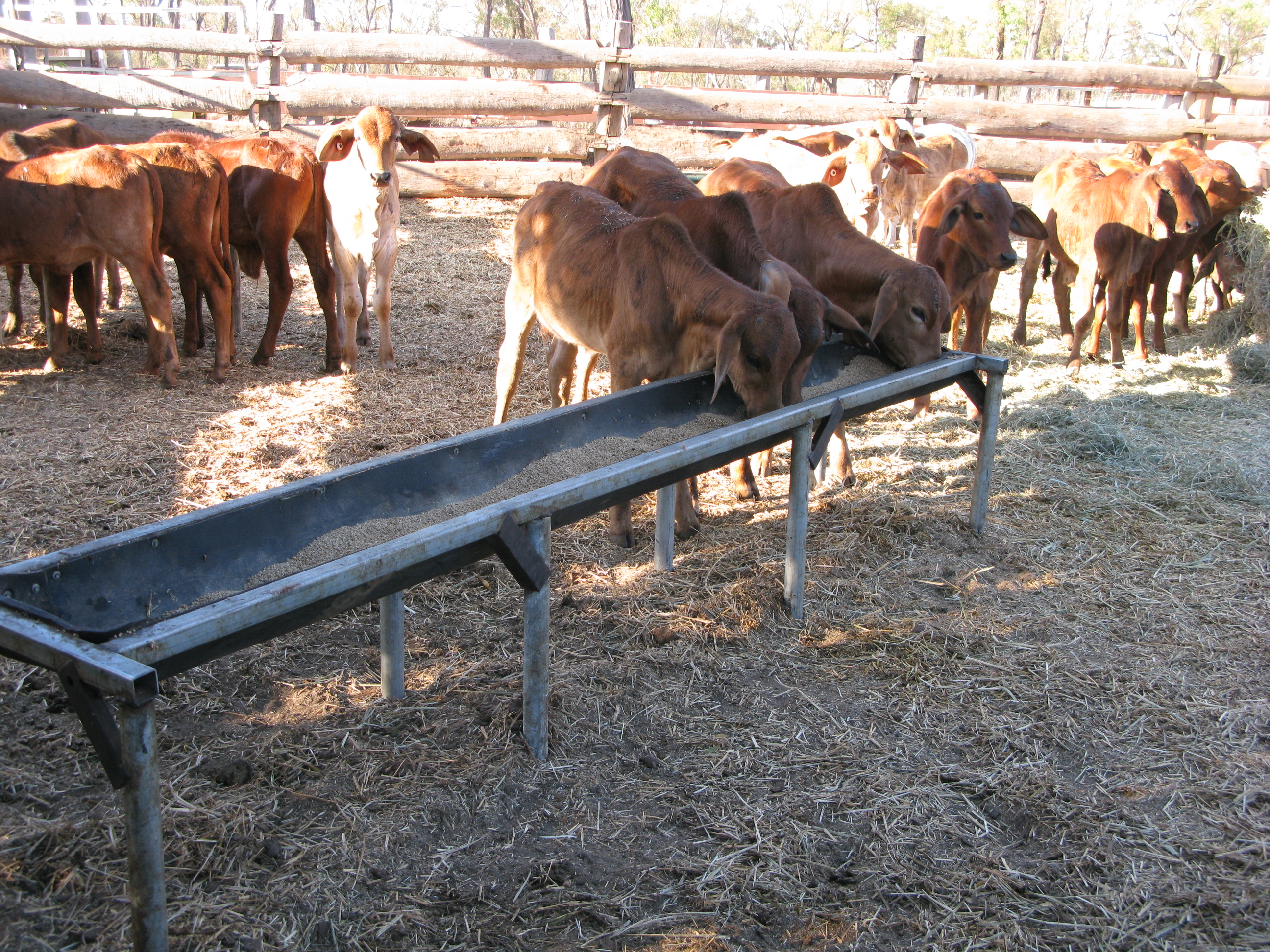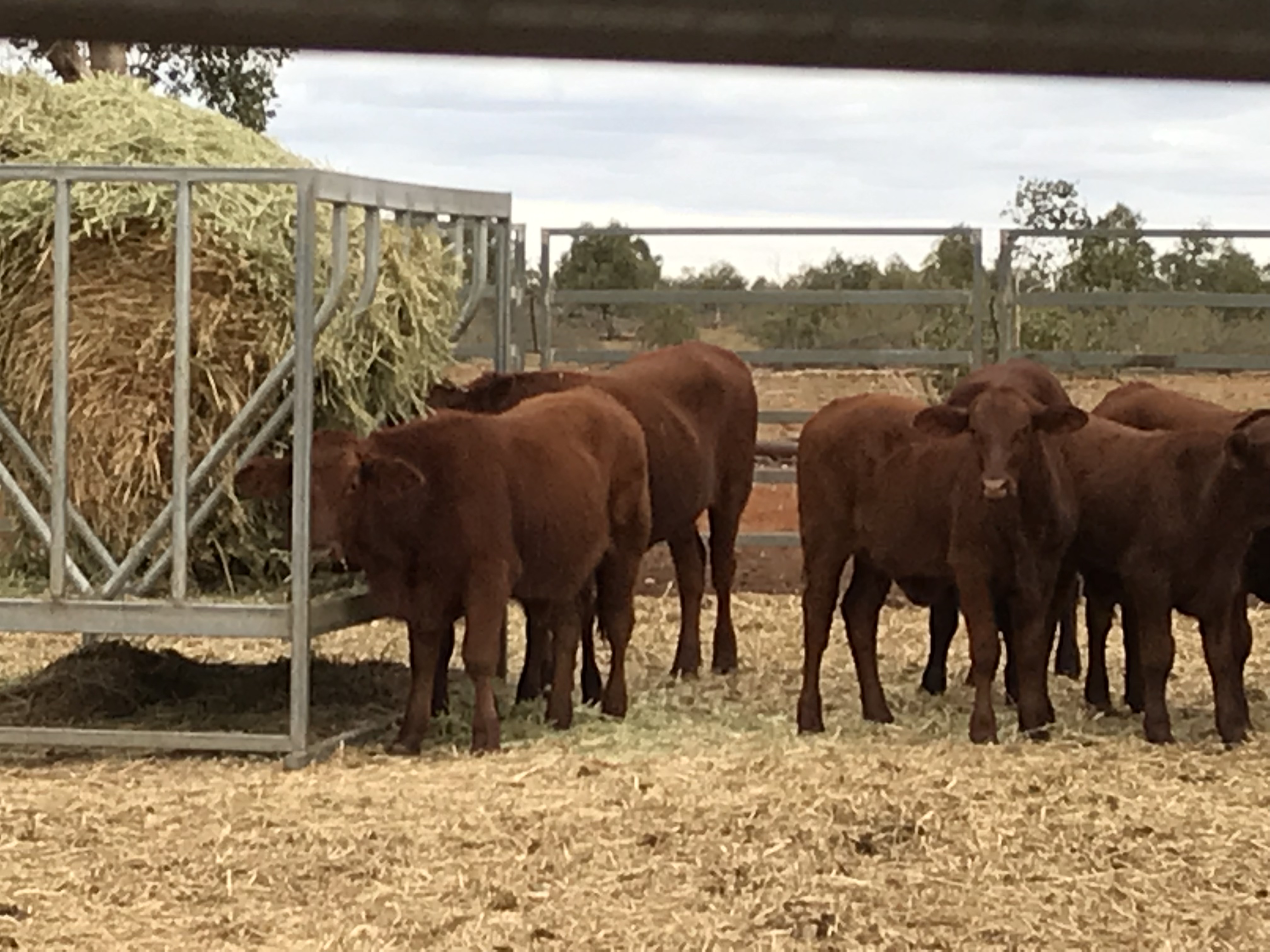Yard weaning and education
Correct management of weaners, including low stress training and education of calves at weaning, sets their pattern of behaviour for the rest of their lives. Making their first experience of handling and husbandry procedures as pleasant as possible reduces the stress experienced throughout their lifetime when similar procedures are carried out. Minimising handling stress of weaners also helps to de-sensitise them to the regular noises and movements of people and vehicles. This results in ease of handling and increased growth performance, so is well worth the initial investment of time.
Before weaning | At weaning | Training | Tailing out | Husbandry procedures | Benefits of yard weaning
Before weaning

Check all of the infrastructure and equipment ahead of time (to avoid injuries and escapes), including yards, hay feeders and water troughs. If different classes of weaners are going to be weaned, ensure there is adequate yard space so animals can be drafted and managed accordingly. Calves get bored and will often manage to open a gate catch by playing with it, so place another chain or wire around gate catches. Before weaning occurs, ensure the water troughs are clean, the hay feeders are full of good quality hay, and the appropriate concentrate is available in the weaning yard (as well as sufficient supplies of feed on hand to cover the weaning period).
At weaning
Following mustering, it is usual to wean calves after drafting and processing the cows. The least stressful method for weaning is to let the cows out into a holding paddock close to the yards with access to pasture. This may not always be possible so an alternative strategy is to move cows as far away as is feasible. Cows find weaning very stressful too, and many cows will break fences and jump grids to return to their calves if they are moved too far apart on the first day of weaning. After three to five days the cows will have forgotten about their calves and will be much easier to move to their paddock.
Weaners require immediate access to good quality hay and feed concentrates (protein and energy) to maintain an active rumen. Supplementation requirements will depend on the weaning weight, with very small weaners requiring a milk replacer and/or high quality calf meal.
Weaning is a good time to teach weaners to eat from a trough. While they are locked in the yard and bored, they will explore new things they wouldn’t normally touch in the paddock. Once weaners are in the yards and drafted from the cows, they should be left overnight to settle. There will be a lot of bellowing from both the cows and the calves, but this is normal.
Training begins
Minimising stress levels around the time of weaning will improve the health of the weaners and will reduce production loss and decrease the potential for injury. In order to help minimise stress, for the first few days, spend time walking quietly through the weaners. Move them slowly and calmly into other yards whilst you fill the hay racks each day. This teaches weaners to walk through gateways and move at your direction whilst familiarising them with human interaction. Having a few quiet, educated, older animals with the weaners is a good way to help with settling the younger weaners, whilst also providing a lead for them to follow.
Working weaners through the yards on foot three to four times over a week will familiarise them with people on the ground. Run the weaners into the working yards and teach them to draft and walk up the race. Do this by letting ten or so go through and stopping the rest. Work the first group of ten through the race and crush without stopping them. Repeat this process until all weaners have been through. By doing this, even the most nervous weaners will learn what is required of them. Weaners should also be taught to “block up” at a shut gate to help minimise injuries and they should be worked through the yards in several directions.
Tailing out
Once the weaners work well through the yards take them to a small paddock or laneway for exposure to the likes of dogs, horses and motorbikes. Open the yard gates and work the lead to slow the weaners if they start to run. If weaners exit the yards at a trot or gallop, block them and re-yard. Repeat this until weaners learn to walk calmly out of the yard. Weaners need to learn that you set the pace, not them. Work weaners around the paddock, letting them graze as you do this. This makes weaners more manageable for future musters, and teaches them to settle and graze when moved to new paddocks. Weaner paddocks require secure fencing to ensure the weaners can be controlled and educated. A laneway paddock is ideal for this work but any small well-fenced paddock will do.
Once you are happy with the way weaners are working, let them have the full day out in the paddock and just yard at night. Ideally weaners should be tailed out in a paddock and yarded at night at least three or four times. This tailing and yarding process is a crucial part of the education process.
Last operations before release
Procedures such as dehorning, branding and castration ideally would have been carried out a few months prior to weaning to reduce stress at weaning time. In the event that weaners have not yet been processed, this should be the last procedure before being turned out into their new paddock. This will help to minimise their exposure to contaminants from the cattle yards and reduce infections. Following this, weaners can go out into a suitable paddock to finish growing. To ensure continued weaner growth and long-term productivity, pastures must be in good condition (both quality and quantity).
While working the weaners, make a note of any animals that do not settle down. If a weaner does not respond to the constant handling at weaning, it will always be difficult to handle and should be identified for culling.
For more information see:
Health
All calves in ticky country should be vaccinated against tick fever at weaning. Once you know how many weaners you have, order the 3–germ blood. Give the weaners their second 5–in–1 (or 7–in–1) vaccination. If they haven’t had any 5–in–1 vaccinations, give them their first injection and the second 4 to 6 weeks later. The stress of weaning tends to lower the calves’ defences, making them more susceptible to internal parasites. If you suspect internal parasites are a problem, test for worm burdens in the calves and drench if appropriate.
Coccidiosis is caused by organisms that live in the calves’ gut and on the ground. The stress of weaning often allows these parasites to multiply and cause problems. The most common symptom is scouring and general ill health. In severe cases the calf can die. Animals less severely affected take a long time to recover because the organism damages the lining of the gut. Feeding calves in racks and troughs will help prevent them picking up the coccidian organism from the ground.
Benefits of yard weaning
The time and cost put into training weaners is recouped many times over as the animals grow and enter the adult herd. Well-trained weaners are a pleasure to work with, whereas cattle that have not been trained well at weaning cause many problems. A good weaner training program over successive years will improve temperament across the whole herd and greatly reduce the risk of personal injury in the yards.
Producers who regularly sell cattle into the store market (saleyards, AuctionsPlus, agent, privately) and do a good job of educating weaners, will quickly get a good reputation and a loyal group of buyers who will pay above market prices to secure these cattle.
Research by the Cooperative Research Centre for Beef Genetic Technologies on the effects of yard weaning, vaccination and yard training on subsequent feedlot performance reaffirmed the benefits of good weaning management. Good yard weaning also ensures cattle go onto feed quicker in feedlots, have less illness, and generally perform better. Cattle weaned in the yards onto hay or silage for 5 to 10 days adapted quickly, ate sooner from the bunk, performed better and had less illness in the feedlot than those weaned in the paddock. In one trial, yard-weaned cattle grew 28% faster over a 78 day feeding period.
If purchasing in cattle, particularly cattle that you are unfamiliar with, ensure they have a few days on feed in the yards, and some weaner training before you let them out. Steers going into a finishing paddock, and replacement heifers going into the breeder herd, will all benefit from a few days of handling and education.
Reference ‘Producing and processing quality beef from Australian cattle herds – Industry outcomes of the Cooperative Research Centre for the Cattle and Beef Industry (Meat Quality) 1993–2000’. P. Dundon, B. Sundstrom, R. Gaden.
Written by Lindy Symes, formerly Queensland Government.
Reviewed and edited by Megan Munchenberg, Joe Rolfe and Bernie English (Department of Agriculture and Fisheries).